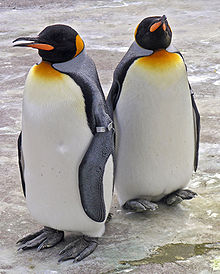- Flightless bird
-
Flightless birds are birds which lack the ability to fly, relying instead on their ability to run or swim. They are thought to have evolved from flying ancestors.[1] There are about forty species in existence today,[2] the best known being the ostrich, emu, cassowary, rhea, kiwi, and penguin. It is believed by some[citation needed][who?] that most flightless birds evolved in the absence of predators on islands, and lost the power of flight because they had few enemies — although this is likely not the case for the ratites (the ostrich, emu and cassowary), as all have claws on their feet to use as a weapon against predators.
Two key differences between flying and flightless birds are the smaller wing bones of flightless birds[3] and the absent (or greatly reduced) keel on their breastbone. The keel anchors muscles needed for wing movement.[2] Flightless birds also have more feathers than flying birds.
New Zealand has more species of flightless birds (including the kiwis, several species of penguins, and the takahe) than any other country. One reason is that until the arrival of humans roughly a thousand years ago, there were no large land predators in New Zealand; the main predators of flightless birds were larger birds.[4]
Some flightless varieties of island birds are closely related to flying varieties, implying flight is a significant biological cost.
The smallest flightless bird is the Inaccessible Island Rail (length 12.5 cm, weight 34.7 g). The largest (both heaviest and tallest) flightless bird, which is also the largest living bird, is the Ostrich (2.7 m, 156 kg), although some extinct species grew to larger sizes.
Flightless birds are the easiest to take care of in captivity because they do not have to be caged. Ostriches were once farmed for their decorative feathers. Today they are raised for meat and for their skins, which are used to make leather.
There were also other families of flightless birds, such as the now extinct Phorusrhacidae, that evolved to be very powerful terrestrial predators.
List of recent flightless birds
The following are flightless birds during or after the Holocene period.
Ratites
- Ostrich
- Emu
- Kangaroo Island Emu (extinct)
- King Island Emu (extinct)
- Cassowaries
- Moa (extinct)
- Elephant birds (extinct)
- Kiwis
- Rheas
Anseriformes (Waterfowl)
- Moa-nalos (extinct)
- Bermuda Island Flightless Duck (extinct)
- Fuegian Steamer Duck
- Falkland Steamer Duck
- Chubut Steamer Duck
- Auckland Teal
- Campbell Teal
- Domestic Duck
- Domestic Goose
- Dromornis (extinct)
- Genyornis (extinct)
- Chendytes lawi (extinct)
- Talpanas (extinct)
- Cnemiornis (extinct)
Galliformes (Wildfowl)
- New Caledonian Giant Megapode (extinct)
- Silkie
- Domestic turkey
- Domestic chicken
Podicipediformes (Grebes)
- Junin Grebe
- Titicaca Grebe
- Atitlán Grebe (extinct, reportedly flightless [Hunter 1988])
Pelicaniformes (Pelicans, Cormorants, et al.)
Sphenisciformes (Penguins)
Coraciiformes (Kingfishers, Hornbills, et al.)
- Giant Hoopoe (extinct)
Ciconiiformes (Herons, Ibis)
- Apteribis (extinct)
- Jamaican Ibis (extinct)
- Réunion Sacred Ibis (extinct)
Gruiformes (Cranes, Rails)
- Cuban Flightless Crane (extinct)
- Red Rail (extinct)
- Rodrigues Rail (extinct)
- Woodford's Rail (probably flightless)
- Bar-winged Rail (extinct, probably flightless)
- Weka
- New Caledonian Rail
- Lord Howe Woodhen
- Calayan Rail
- New Britain Rail
- Guam Rail
- Roviana Rail ("flightless, or nearly so" [Taylor 1998])
- Tahiti Rail (extinct)
- Dieffenbach's Rail (extinct)
- Chatham Rail (extinct)
- Wake Island Rail (extinct)
- Snoring Rail
- Inaccessible Island Rail
- Laysan Rail (extinct)
- Hawaiian Rail (extinct)
- Kosrae Crake (extinct)
- Ascension Crake (extinct)
- Red-eyed Crake
- Invisible Rail
- New Guinea Flightless Rail
- Lord Howe Swamphen (extinct, probably flightless)
- North Island Takahe (extinct)
- Takahe
- Samoan Wood Rail
- Makira Wood Rail
- Tristan Moorhen (extinct)
- Gough Island Moorhen
- Tasmanian Nativehen
- Giant Coot (adults only; immatures can fly)
- Adzebills (extinct)
Charadriiformes (Gulls, Terns, Auks)
- Great Auk (extinct)
- Diving Puffin (extinct)
Falconiformes (Birds of prey)
- Terrestrial Caracara (extinct)
Psittaciformes (Parrots)
- Kakapo
- Broad-billed Parrot (extinct)
Columbiformes (Pigeons, Doves)
- Dodo (extinct)
- Rodrigues Solitaire (extinct)
- Viti Levu Giant Pigeon (extinct)
Caprimulgiformes (Nightjars)
- New Zealand Owlet-nightjar (extinct)
Strigformes (Owls)
- Cuban Giant Owl (extinct)
- Cretan Owl (extinct, probably flightless)
- Andros Island Barn Owl (extinct)
Passeriformes (Perching Birds)
- Stephens Island Wren (extinct)
- Long-legged Bunting (extinct)
See also
References
- Hunter, Laurie A (1988). "Status of the Endemic Atitlan Grebe of Guatemala: Is it Extinct?" (pdf). Condor 90 (4): pp. 906–912. doi:10.2307/1368847. JSTOR 1368847. http://elibrary.unm.edu/sora/Condor/files/issues/v090n04/p0906-p0912.pdf. Retrieved 2007-04-03.
- Taylor, Barry (1998). Rails: A Guide to the Rails, Crakes, Gallinules and Coots of the World. Yale University Press. ISBN 0-300-07758-0.
- ^ "New Zealand Ecology - Moa". TerraNature. http://www.terranature.org/moa.htm. Retrieved 2007-08-27.
- ^ a b "The Bird Site: Flightless Birds". Archived from the original on 2007-07-13. http://web.archive.org/web/20070713081647/http://www.nhm.org/birds/guide/pg019a.html. Retrieved 2007-08-27.
- ^ Nudds, R. L. and Slove Davidson, J. 2010. A shortening of the manus precedes the attenuation of other wing-bone elements in the evolution of flightlessness in birds, Acta Zoologica 91, 115–122.
- ^ "New Zealand's Icon:Flightless". Archived from the original on 2007-08-18. http://web.archive.org/web/20070818122353/http://www.savethekiwi.org.nz/AboutTheBird/NewZealandsIcon/KiwiCharacteristics/Flightless.htm. Retrieved 2007-08-27.
External links
- TerraNature pages on New Zealand flightless birds
- Kiwi in Te Ara - the Encyclopedia of New Zealand
- The Flightless Birds Band
- Flightless birds in New Zealand
Categories:- Flightless birds
Wikimedia Foundation. 2010.











